Building a local online marketing strategy for your small business isn’t guesswork. Mounting an effective campaign takes time, planning, and resources. From making your website shoot to the top of Google search results to just getting people talking about your business, here are more than a dozen local online marketing tips to help you gain customers and grow your sales.
1. Optimize Your Website for Local Search
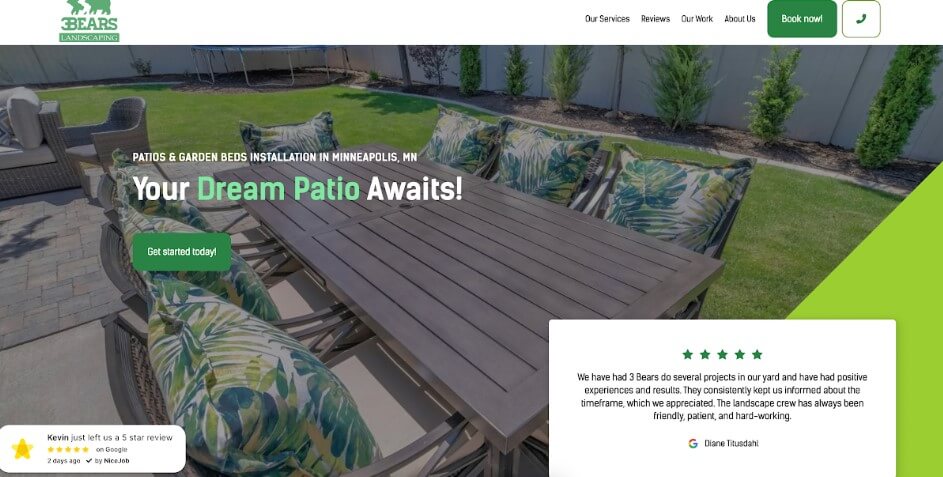
The website for 3 Bears Landscaping includes Minneapolis in its heading, as well as customer reviews from Google.
The hub of local online marketing for any business is its website. Local search engine optimization (SEO) is a must-do if you want your business to succeed. Every day, more and more customers are turning to Google and Bing to find local businesses to provide them with products and services. In fact, local SEO is one of the best website marketing strategies you can undertake.
Optimizing your website for local SEO isn’t complicated, but it does take a bit of research and planning. You don’t have to go in blind—read our guide to local SEO to find out more.
If you lack the time or technical know-how for local SEO, there are affordable options for your small business. Straight North, an agency that specializes in local SEO for small businesses and startups, can put your business on the map in local search results. Visit Straight North’s website to learn more about its services.
2. Create Dedicated Landing Pages for Each Location
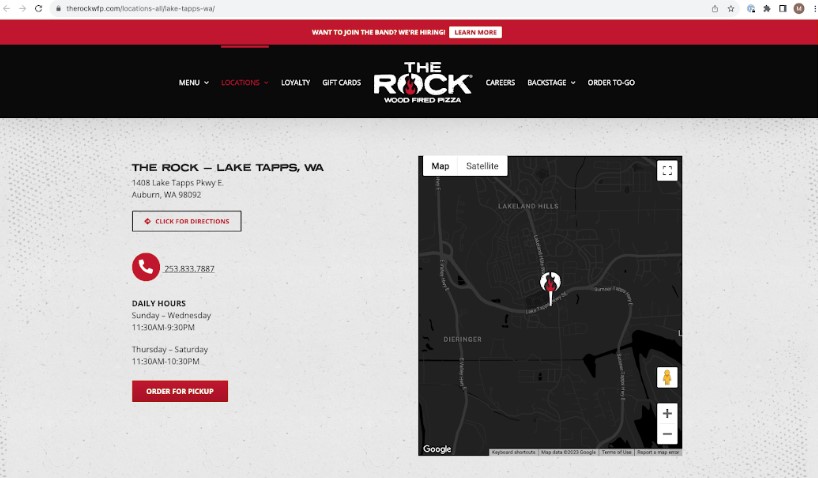
Location-specific landing pages help drive customers to the right location. (Source: The Rock Wood Fired Pizza)
For small businesses operating multiple locations, directing customers to the right place can be challenging. To make this easier, build landing pages for each location and include the location’s address, hours of operation, and directions on how to get there. You can even incorporate a Google Map widget to display that location right on your website.
Local landing pages are important because they provide Google a place to point customers when that customer searches for your business “near me.” By providing a landing page for each location, you can ensure your customers arrive at the right place.
3. Verify Your Site Is Mobile-friendly
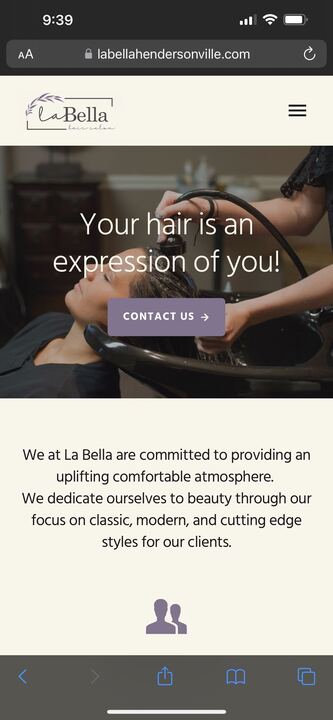
La Bella Salon’s website scales perfectly to fit an iPhone screen.
More than 60% of all internet searches are done on a mobile phone. At the same time, Google changed its search parameters to a “mobile-first” strategy in 2021—and completed this for virtually all businesses by the end of 2022. For your small business website to succeed, you must ensure it is mobile-friendly.
The best website builders and WordPress themes are responsive—meaning that the website scales to fit whatever screen it’s being displayed on. But don’t just rely on a website builder. Visit your site from a phone and tablet to make sure it is displaying correctly. This will both improve your user’s experience (UX) and Google rankings.
All-in-one site builders like Wix and Squarespace have features for local SEO baked in. Learn more about these and other options in our list of the best website builders for SEO.
4. Claim & Optimize Your Google Business Profile
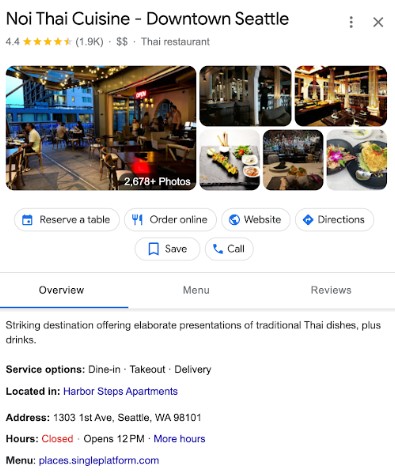
A Google Business Profile can help ensure your business appears in the Google Map Pack.
A Google Business Profile is a free service Google provides to businesses to help customers find the products and services they’re looking for. Formerly known as Google My Business, these profiles appear when someone either searches for your business by name or clicks on your business in the Google Map Pack.
It’s easy to claim or create a Google Business Profile. You’ll answer a few questions about your business, select categories of products or services, and provide information like address and operating hours. Be sure to include as much information as you can about your business, as this leads to improved search results.
Google is just one of many online business directories that allow you to create a free profile that links back to your website. Not only does this benefit your website’s local SEO, but it also provides more ways for customers to discover your small business.
5. Claim Your Yelp Business Profile
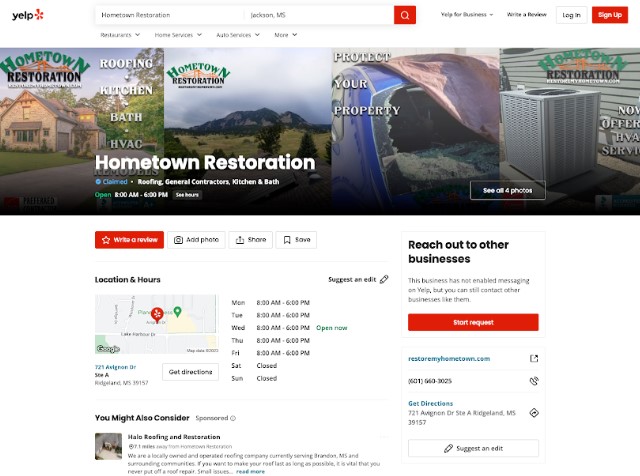
The Yelp profile for Hometown Restoration includes office hours, contact information, and location.
Yelp is a popular online business directory where potential customers can find your business and check customer reviews. Claiming your Yelp business listing can help attract customers and drive customer engagement through positive reviews left on the site.
To claim your Yelp business profile, visit Yelp’s website and click “Verify my free listing.” You’ll be asked to provide some information about your business. You can also optimize your listing to help you rank on Google. Visit our guide to Yelp for business owners to learn more about how you can use Yelp to your advantage.
6. Run Google Ads
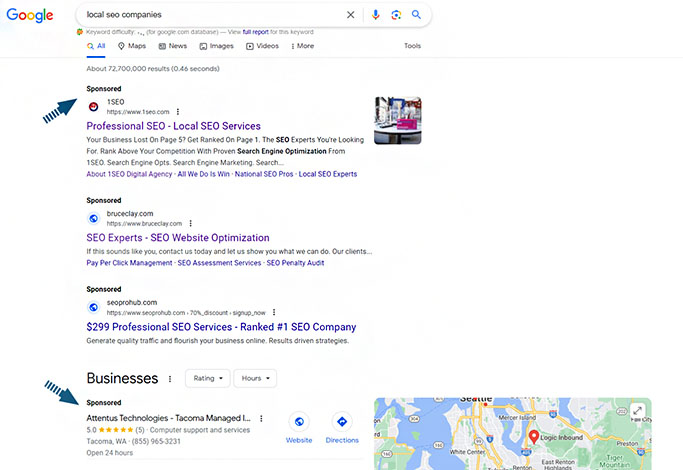
Google Ads for local SEO companies displaying the Sponsored label
When you search Google and the first results say “Sponsored,” those are Google Ads. Google Ads are important because research shows more than 90% of search engine users will select results on the first page of Google. Advertising with Google Ads guarantees your listing will show up near the top of the results.
Google Ads charge based on a pay-per-click (PPC) model. With PPC ads, any time a visitor clicks your ad, you get charged whatever the going rate for that ad is. Prices for PPC ads on Google range from just a few cents to more than $10, depending on the industry in which you operate.
With Google, you can use Google Ads and pay per click when someone clicks on your ad. Alternatively, you can pay only for leads with Google Local Services Ads, which are specifically for local service-based businesses. Learn more about Local Services Ads below.
7. Build a Google Local Services Ads Campaign
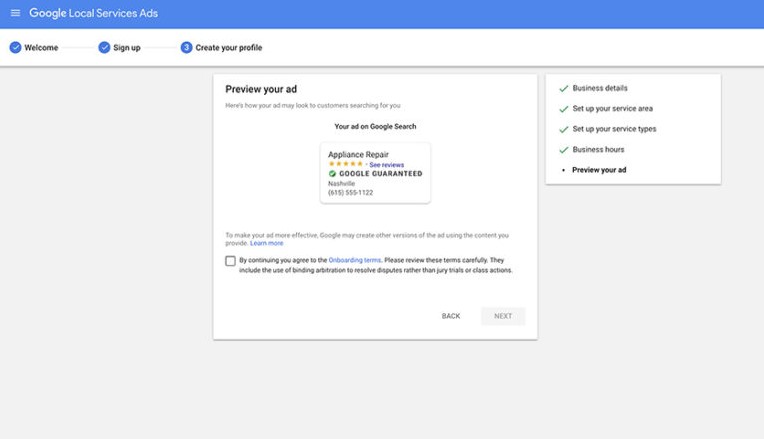
During setup, you’ll get to preview what your Local Service Ad will look like on Google.
If you operate a service-based business, you may be eligible to place Google Local Services Ads. These ads appear at the top of some searches and provide advertising for your business alongside other businesses in your industry. They are only available to companies that operate in certain industries.
Setting up Google Local Services Ads is a straightforward process. It starts with verifying your business’ eligibility in your market. Below are just some of the types of businesses that may be eligible to place these ads.
Types of Businesses Eligible for Google Local Services Ads | ||
|---|---|---|
Acupuncturist Animal shelter Appliance repair Bankruptcy lawyer Beauty school Business lawyer Carpenter Carpet cleaning Childcare Contract lawyer Countertop pro Criminal lawyer Dance instructor Disability lawyer Driving Instructor DUI lawyer Electrician Estate lawyer Family lawyer Fencing pro Financial planner First aid trainer Flooring pro Foundation pro Funeral home | Garage door pro General contractor Handyman Home inspector Home security Home theater House cleaner HVAC Immigration lawyer IP lawyer Junk removal Labor lawyer Landscaper Language instructor Lawn care Litigation lawyer Locksmith Malpractice lawyer Massage school Mover Personal injury lawyer Personal trainer Pest control Pet adoption Pet boarding | Pet grooming Pet trainer Plumber Pool cleaner Pool contractor Preschool Real estate agent Real estate lawyer Roofer Sewage pro Siding pro Snow removal Tax lawyer Tax specialist Traffic lawyer Tree service Tutor Veterinarian Water damage Weight loss service Window cleaner Window repair Yoga instructor |
8. Create a Facebook Profile for Your Business
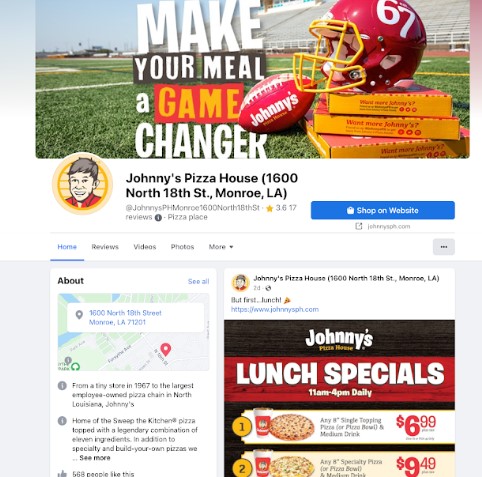
The Facebook page for a pizzeria in Monroe, LA (Source: Johnny’s Pizza House page on Facebook)
Connecting with customers on social media is a great way to get the word out about your small business, special events, and limited-time offerings. You can create a Facebook page in just a few steps, and once you’ve created your page, inviting friends and family to interact with that page is a great way to drive early traffic.
Having a Facebook page for your business lets customers know you’re engaged with the local business community. It’s an interactive way to get free publicity, and customers can like and share posts that they feel their friends will enjoy. In fact, you can even incentivize customer interaction by offering special discounts for those who like and share posts.
Learn more about Facebook marketing strategies in our comprehensive guide.
9. Place Facebook Ads
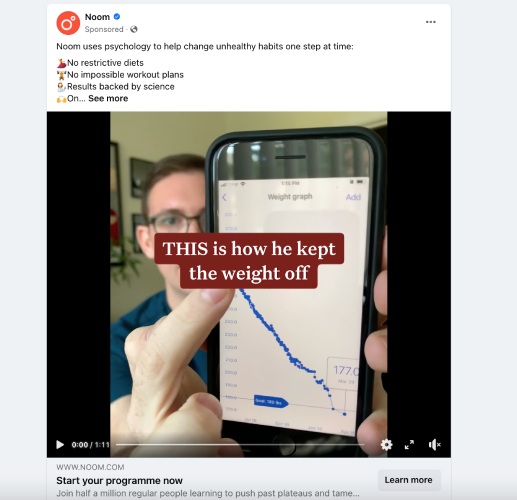
An ad for the fitness app Noom features a video and captions to grab the user’s attention.
Facebook ads offer one of the easiest ways to target specific groups of potential customers thanks to its advertising audience targeting features. You can choose from dozens of factors, including location and interests, to build advertisements specifically aimed at certain potential customers. This increases the effectiveness of the ad and lowers your overall customer acquisition cost (CAC).
To get started with Facebook ads, read our beginners guide to Facebook advertising. Then, head over to the Meta Ads Manager to sign up for your Facebook Ads account and get started building your campaign.
Pro tip: You can build a great local marketing plan with just a little effort. Use our guide to local marketing plans, complete with a downloadable template, to get started.
10. Remarket to Past Website Visitors
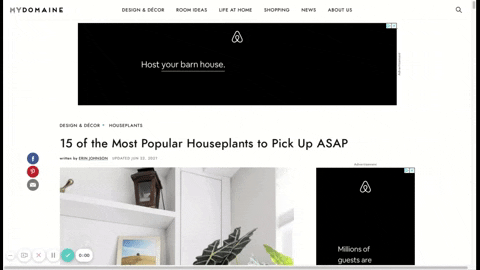
Airbnb remarkets to visitors across a wide range of websites.
Remarketing refers to using web banner ads (aka display advertising) on third-party websites. These ads are served up to people who visited your website in the past using a Google tag (code) or Facebook pixel. The pixel records the site visitor’s IP address, then when they are on other sites in the Google or Facebook ad network, your web banner ads are shown to them.
Display advertising through remarketing sounds technical (and it is), but it’s actually very easy to set up:
- Read Google’s setup guide for Google Remarketing
- Check out Facebook’s instructions for creating Facebook remarketing campaigns
Once set up, remarketing ads generally cost pennies on the dollar compared to pay-per-click ads on Google or Facebook. These remind former site visitors about your business, often as they are researching solutions, keeping your brand top of mind (and thus, increasing the chances they will buy from your business).
11. Send SMS Text & Email Marketing Messages
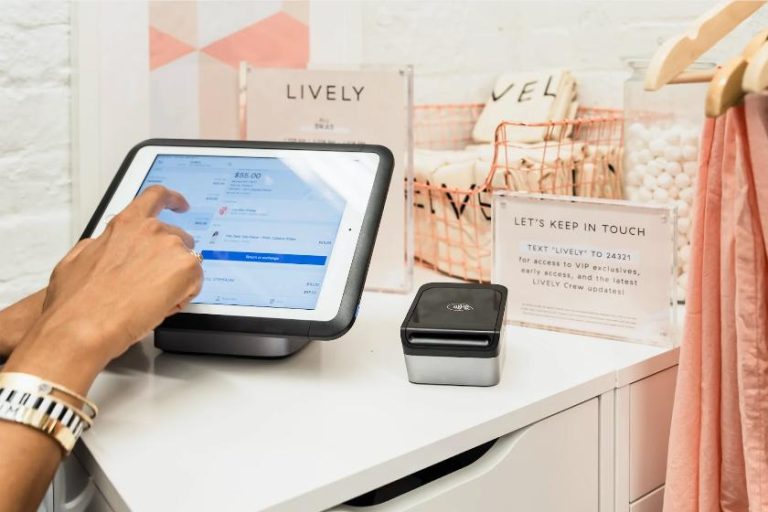
Collecting email addresses at the point-of-sale is a great way to build an email list.
Opt-in email marketing is one of the least expensive and most effective ways to talk directly to your customers. Frequent shoppers are usually more than willing to provide their email address—provided that you deliver information and offers that are valuable to them. Many small businesses even incentivize customers to share an email address by offering a discount to do so.
Using email marketing software like Mailchimp, you can set up a sales-producing campaign in minutes or set up a drip email campaign that nurtures your leads over time. Businesses with multiple locations can also use audience segmentation to target emails only to customers of specific locations. Discover how to make an email marketing plan using our free template.
Increasingly, email marketing apps also offer the ability to send bulk SMS marketing campaigns. As with email, you’ll want to get permission before sending text marketing campaigns. Both email and text marketing offer the ability to personalize your local online marketing to your audience to increase conversions, referrals, and brand affinity overall.
12. Get Reviews on Google & Yelp

Dallas Dental Arts has amassed more than 270 positive reviews.
One factor Google takes into account when ranking businesses in its search results is your Google Reviews profile. It looks at how many reviews your business has and what customers think of your business. The more positive reviews you have, the higher Google ranks you in the search engine results pages (SERPs).
Getting more Google reviews can be challenging. However, the most effective way to do so is to ask customers to leave a note about their experience. You can do this verbally, on your receipt, or with signage in your store. Google will even provide you a downloadable and printable display advertising with scannable QR codes to direct customers to your review page.
A word of caution: Whatever you do, don’t incentivize customers to leave reviews with discounts or free products. Google algorithms can detect such review patterns and will ding your search rating as a result. The same goes for asking friends and family. Only solicit reviews from actual, paying customers.
13. Encourage Customers to Refer Your Business

Get customers talking about your small business (Source: Ekaterina Bolovstova, Pexels)
Perhaps the best way to market your business locally is to encourage customers to share the word about your small business with their friends and family. Word-of-mouth is a powerful driver of brand presence, and people tend to trust what others have to say about your business more than the advertising you do.
You can incentivize customers to invite friends into your business with coupons or discounts. You can provide regular customers with promotional materials to share with their friends. But perhaps the best local marketing idea for building your reputation in the community is to simply ask happy customers to spread the word.
14. Generate Local Online Marketing Buzz With Press Releases
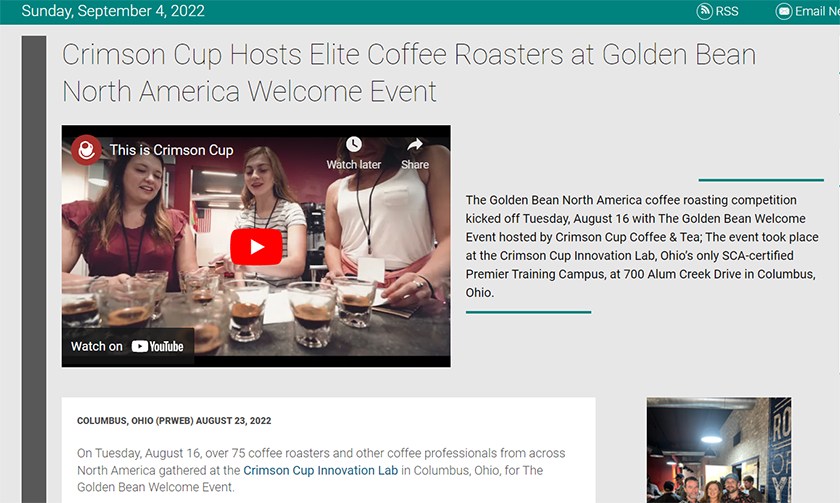
Press release about a local company hosting an event for coffee roasters (Source: Crimson Cup via PRWeb)
Press releases offer the ability for you to build awareness and affinity for your brand online. Whether you publish them only on your website’s media or “About us” page, or you opt for mass local media placements via press release distribution services, these provide a de facto endorsement of your business that feels more objective than typical sales or marketing copy.
Writing a press release is different from other types of marketing materials. But you can shortcut the process with tools like artificial intelligence (AI) with AI press release generators. They will put your release into the proper format, so all you’ll need to do is edit the copy generated to personalize it to your brand, audience, and newsworthy story.
Benefits of Local Online Marketing for Small Businesses
Among the benefits of online local marketing, you can attract additional foot traffic, increase sales, and grow word of mouth. Here are a few statistics to back up the importance of your digital marketing efforts:
- As much as 46% of all Google searches have a local search intent. (Safari Digital)
- 97% of internet users check a company’s online presence before deciding to visit their business. (WebFX)
- 76% of consumers check online reviews before choosing a local business. (On the Map)
- Semrush tracks more than 5 million keywords related to “near me” searches. (Soci)
- 61% of mobile users are more likely to connect with your business if it has a mobile-friendly website. (HubSpot)
- Worldwide ecommerce is a $6 trillion industry. (Statista)
Frequently Asked Questions (FAQs)
What are examples of local online marketing?
Local online marketing includes many different types of activities, such as:
- Implementing local website SEO
- Creating listings on Google, Yelp, and Angi
- Leveraging social media
- Utilizing Google Ads and Local Services Ads
- Email marketing
- Remarketing to past website visitors
- Getting reviews on Google and Yelp
How can I promote a local business online for free?
There are several ways to promote your local business online for free. You can claim your Google, Bing, and Angi business profiles. Also, you can establish a social media presence for your small business. Collecting email addresses and sending email and SMS text marketing campaigns is another way you can connect with customers for free.
Many email marketing providers offer free-forever plans. Learn more with our guide to the best email marketing software.
How do I target my marketing to a local area?
Targeting your marketing to a local area is simple. Optimize your website for local search and build landing pages for each location of your business. Claim profiles on Google, Bing, Yelp, and Angi, and encourage your customers to leave reviews. Create social profiles on the apps your target audience uses most. Then, when you post content, include a local focus for that content by mentioning your location, your city, or even your neighborhood.
Bottom Line
The key takeaway for building a local online marketing strategy is to plan and execute an effective, multi-channel strategy. There are cheap or even free tools at your disposal to help you do everything, from advertising on Google to optimizing your website for local search. By following these tips, you’ll be well on your way to maximizing your local digital marketing efforts.
Prefer to leave your online marketing and advertising plan to the experts? You can’t go wrong with our top-recommended digital marketing agency Straight North. Straight North works with startups and small businesses to create a tailored plan that encompasses local SEO, website optimization, advertising, and more. Reach out for a free consultation today.